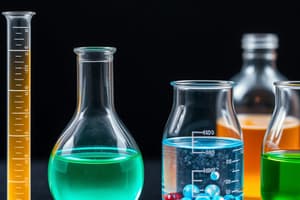Podcast
Questions and Answers
What is the pH level of a neutral solution?
What is the pH level of a neutral solution?
- 9
- 8
- 6
- 7 (correct)
Bases taste sour.
Bases taste sour.
False (B)
What is produced in a neutralization reaction?
What is produced in a neutralization reaction?
Salt and water
The pH level of acids is ______.
The pH level of acids is ______.
Match the following properties with acids or bases:
Match the following properties with acids or bases:
Which of the following is a property of bases?
Which of the following is a property of bases?
Salts can be used as preservatives in the food industry.
Salts can be used as preservatives in the food industry.
In the reaction NaOH + HCl, the products are ______ and ______.
In the reaction NaOH + HCl, the products are ______ and ______.
Flashcards are hidden until you start studying
Study Notes
Properties of Acids
- Taste: Sour (e.g., citric acid in lemons).
- Reactivity: React with metals to produce hydrogen gas.
- pH Level: Less than 7.
- Indicators: Turn blue litmus paper red.
- Conductivity: Good conductors of electricity when dissolved in water.
- Corrosive: Can damage organic tissues and metals.
Properties of Bases
- Taste: Bitter (e.g., baking soda).
- Texture: Slippery or soapy feel when in solution.
- pH Level: Greater than 7.
- Indicators: Turn red litmus paper blue.
- Conductivity: Also good conductors of electricity when dissolved in water.
- Neutralization: Can neutralize acids to form water and salt.
pH Scale
- Range: 0 to 14.
- Acidic: pH < 7.
- Neutral: pH = 7 (pure water).
- Basic/Alkaline: pH > 7.
- Measurement: Indicates the concentration of hydrogen ions (H⁺) in a solution.
- Logarithmic Scale: Each unit change in pH represents a tenfold change in acidity or basicity.
Neutralization Reactions
- Definition: Reaction between an acid and a base to produce salt and water.
- General Equation: Acid + Base → Salt + Water.
- Example: HCl + NaOH → NaCl + H₂O.
- Heat Production: Often exothermic, releasing heat.
Applications of Salts
- Food Industry: Used as preservatives and flavor enhancers (e.g., sodium chloride).
- Medical Uses: Electrolyte balance (e.g., potassium chloride).
- Agriculture: Fertilizers (e.g., ammonium sulfate).
- Chemical Industry: Raw materials for various chemical processes.
- De-icing: Salts like calcium chloride used to melt ice on roads.
Reactions
- Acid-Base Reactions: Form salts and water, essential for various chemical processes.
- Reactions with Metals: Acids react with metals to produce hydrogen gas and salts.
- Reactions with Carbonates: Acids react with carbonates to produce carbon dioxide, water, and salts (e.g., HCl + Na₂CO₃ → NaCl + H₂O + CO₂).
- Hydrolysis of Salts: Salts can react with water to form acidic or basic solutions, affecting pH.
Properties of Acids
- Characterized by a sour taste, as seen in citric acid from lemons.
- React readily with metals, releasing hydrogen gas as a byproduct.
- Have a pH level lower than 7, indicating their acidic nature.
- Change blue litmus paper to red due to their nature.
- Capable of conducting electricity well when dissolved in water.
- Can cause damage to organic tissues and metals due to their corrosive properties.
Properties of Bases
- Exhibit a bitter taste, commonly found in substances like baking soda.
- Have a slippery or soapy feel when dissolved in water.
- Possess a pH level greater than 7, categorizing them as basic.
- Transform red litmus paper to blue, indicating their basic nature.
- Also good conductors of electricity when in solution.
- Neutralize acids to produce water and salt in a chemical reaction.
pH Scale
- Ranges from 0 to 14, providing a measure of acidity or basicity.
- Acidic solutions have a pH less than 7, while basic solutions exceed a pH of 7.
- Pure water is neutral, maintaining a pH of exactly 7.
- Indicates the concentration of hydrogen ions (H⁺) within a solution.
- The scale is logarithmic, meaning each unit change in pH reflects a tenfold increase or decrease in acidity or basicity.
Neutralization Reactions
- Defined as the chemical reaction between an acid and a base resulting in salt and water.
- Follow the general equation: Acid + Base → Salt + Water.
- An example includes the reaction: HCl + NaOH → NaCl + H₂O.
- Such reactions are typically exothermic, generating heat during the process.
Applications of Salts
- Widely utilized in the food industry as preservatives and flavor enhancers, e.g., sodium chloride.
- Play a crucial role in medical fields for maintaining electrolyte balance, exemplified by potassium chloride.
- Essential in agriculture, primarily as fertilizers like ammonium sulfate.
- Serve as raw materials for diverse chemical processes within the chemical industry.
- Used for de-icing roads; calcium chloride is especially effective for melting ice.
Reactions
- Acid-base reactions are vital, producing salts and water, integral to numerous chemical processes.
- Acids interact with metals, yielding hydrogen gas and salts.
- React with carbonates to release carbon dioxide, water, and salts, illustrated by the equation: HCl + Na₂CO₃ → NaCl + H₂O + CO₂.
- Salts can undergo hydrolysis in water, forming solutions that are either acidic or basic and influence pH levels.
Studying That Suits You
Use AI to generate personalized quizzes and flashcards to suit your learning preferences.




